An IoT Smart Rodent Bait Station System Utilizing Computer Vision
Abstract
1. Introduction
2. Related Work
3. System Requirements
4. System Design
- Device token
- Temperature
- Humidity
- Battery Voltage
- Captured Image
4.1. Image Acquisition
- To illuminate the entire bait rod so that the bait estimation algorithms worked optimally.
- To create an illumination system which would not scare a rodent away as soon as it is turned on.
- To optimize the lighting system so that it consumes low power when on.
4.2. Sensor Data Acquisition
4.3. Communications Infrastructure
4.4. Image Processing
- Identify the type of bait in the image
- Estimate the bait level in the image
- Detect whether there is a rodent in the image
4.5. Data Presentation
4.6. Power Considerations
- Placing the STM microcontroller into deep sleep when no motion is detected in the trap and no timer interrupt is triggered.
- Limiting the number of images captured for bait estimation to one per day if the bait station is visited often, or one per week if the bait station is seldom visited.
- Limiting the number of images captured while an intruder is present in the bait station, regardless of how long the intruder stays in the station.
- Limiting the number of times the RatSpy Client Module connects to the RatSpy Server Module. Captured images can be saved to the SD card and later sent as a batch at a specified time (for example once every few days, depending on the number of images captured).
5. System Evaluation and Discussion
- Traditional: Bait checked manually by human operators every 2 weeks. Rodent scat observed and noted in the field
- Trigger Report: A PIR sensor or break-beam sensor is used to record presence of an intruder which is logged to a server
- Trail Camera: Motion triggered cameras capture images of animals moving nearby
- Displacement Sensor: A high-resolution rangefinder for estimating bait levels
- Vision Estimation and Capture (RatSpy): Using machine vision to estimate bait levels and capture pictures of intruders
5.1. Image Clarity
5.2. Bait Estimation
5.3. Triggering Efficacy
5.4. Power Efficiency
6. Conclusions
Author Contributions
Funding
Acknowledgments
Conflicts of Interest
References
- Bell, W.G. The Great Plague in London in 1665; The Bodley Head Ltd.: London, UK, 1924. [Google Scholar]
- Bennett, G.W.; Owens, J.M.; Corrigan, R.M. Truman’s Scientific Guide to Pest Control Operations, 5th ed.; Advanstar Communications: Cleveland, OH, USA, 1997. [Google Scholar]
- Pimentel, D.; Zuniga, R.; Morrison, D. Update on the environmental and economic costs associated with alien-invasive species in the United States. Ecol. Econ. 2005, 52, 273–288. [Google Scholar] [CrossRef]
- IBISWorld Industry. IBISWorld Industry Report N7312: Building Pest Control Services in Australia; IBISWorld Industry: Melbourne, Australia, 2019; Available online: https://www.ibisworld.com/au/list-of-industries (accessed on 18 August 2020).
- Prakash, I. Rodent Pest Management; CRC Press: Boca Raton, FL, USA, 2018. [Google Scholar]
- Khan, S.A.; Schell, M.M. Anticoagulant Rodenticides (Warfarin and Congeners). In MSD Veterinary Manual; Merck & Co., Inc.: Kenilworth, NJ, USA, 2019. [Google Scholar]
- Buckle, A.; Smith, R. Rodent Pests and Their Control, 2nd ed.; CABI: Wallingford, UK, 2015. [Google Scholar]
- Kohn, M.H.; Pelz, H.J.; Wayne, R.K. Natural selection mapping of the warfarin-resistance gene. Proc. Natl. Acad. Sci. USA 2000, 97, 7911–7915. [Google Scholar] [CrossRef] [PubMed]
- Gummin, D.D.; Mowry, J.B.; Spyker, D.A.; Brooks, D.E.; Osterthaler, K.M.; Banner, W. 2017 Annual Report of the American Association of Poison Control Centers National Poison Data System (NPDS): 35th Annual Report. Clin. Toxicol. 2018, 56, 1213–1415. [Google Scholar] [CrossRef] [PubMed]
- Rattner, B.A.; Lazarus, R.S.; Elliott, J.E.; Shore, R.F.; Van den Brink, N. Adverse outcome pathway and risks of anticoagulant rodenticides to predatory wildlife. Environ. Sci. Technol. 2014, 48, 8433–8445. [Google Scholar] [CrossRef] [PubMed]
- Campbell, K.J.; Beek, J.; Eason, C.T.; Glen, A.S.; Godwin, J.; Gould, F.; Holmes, N.D.; Howald, G.R.; Madden, F.M.; Ponder, J.B. The next generation of rodent eradications: Innovative technologies and tools to improve species specificity and increase their feasibility on islands. Biol. Conserv. 2015, 185, 47–58. [Google Scholar] [CrossRef]
- Rodenticides; Notice of Intent to Cancel Registrations of, and Notice of Denial of Applications for, Certain Rodenticide Bait Products [EPA-HQ-OPP-2013-0049; FRL-9377-7]; Environmental Protection Agency: Washington, DC, USA, 2013.
- Bruyndonckx, R. Guideline on Best Practice in the Use of Rodenticide Baits as Biocides in the European Union. Eur. Biocidal Prod. Forum 2013, 13–14. Available online: https://www.pestmagazine.co.uk/media/242685/ebpf-cefic-guideline-on-best-practice-in-the-use-of-rodenticides-in-the-eu-sep-2013.pdf (accessed on 18 August 2020).
- Free, C.L.; Leung, L.P. How effective are grid trapping, oil cards and track boards in monitoring bush rat populations? Aust. Mammal. 2008, 29, 149–155. [Google Scholar] [CrossRef]
- Sweetapple, P.; Nugent, G. Chew-track-cards: A multiple-species small mammal detection device. N. Z. J. Ecol. 2011, 153–162. [Google Scholar]
- Parsons, L.; Ross, R.; Robert, K. A survey on wireless sensor network technologies in pest management applications. Appl. Sci. 2020, 2, 28. [Google Scholar] [CrossRef]
- Rentokil. Technical Support: Remote Monitoring (Pestconnect). 2020. Available online: https://www.rentokil.com.au/mice/radar/ (accessed on 1 August 2020).
- Kim, B.M. Mouse and Rat Trap. U.S. Patent 5,953,853, 21 September 1999. [Google Scholar]
- Nooski. Nooki Trap Systems. Available online: https://nooski.com/ (accessed on 1 August 2020).
- Goodnature. A24 Rodent Control System. Available online: http://www.goodnature.com.au/ (accessed on 1 August 2020).
- Clapperton, B.K. A Review of the Current Knowledge of Rodent Behaviour in Relation to Control Devices; Science & Technical Pub., Department of Conservation: Wellington, New Zealand, 2006; Volume 263. [Google Scholar]
- Anticimex. SMART—A More Intelligent Solution to Pest Control. Available online: www.anticimex.com/smart-pest-control (accessed on 1 August 2020).
- Nibali, A.; Ross, R.; Parsons, L. Remote Monitoring of Rodenticide Depletion. IEEE Internet Things J. 2019, 6, 7116–7121. [Google Scholar] [CrossRef]
- Kariduraganavar, R.M.; Yadav, S.S. Design and Implementation of IoT Based Rodent Monitoring and Avoidance System in Agricultural Storage Bins. In Emerging Trends in Photonics, Signal Processing and Communication Engineering; Springer: Berlin/Heidelberg, Germany, 2020; pp. 233–241. [Google Scholar]
- Baranwal, T.; Nitika; Pateriya, P.K. Development of IoT based smart security and monitoring devices for agriculture. In Proceedings of the 2016 6th International Conference-Cloud System and Big Data Engineering (Confluence), Noida, India, 14–15 January 2016; pp. 597–602. [Google Scholar]
- Lavelle, M.J.; Snow, N.P.; Halseth, J.M.; Kinsey, J.C.; Foster, J.A.; VerCauteren, K.C. Development and evaluation of a bait station for selectively dispensing bait to invasive wild pigs. Wildl. Soc. Bull. 2018, 42, 102–110. [Google Scholar] [CrossRef]
- ISO/IEC 25010:2011. Systems and Software Engineering—Systems and Software Quality Requirements and Evaluation (SQuaRE)—System and Software Quality Models; ISO: Geneva, Switzerland, 2011. [Google Scholar]
- Sturm, P.; Ramalingam, S.; Tardif, J.P.; Gasparini, S.; Barreto, J. Camera models and fundamental concepts used in geometric computer vision. Found. Trends Comput. Graph. Vis. 2011, 6, 1–183. [Google Scholar]
- OpenCV: Fisheye Camera Model. Available online: https://docs.opencv.org/3.4/db/d58/group__calib3d__fisheye.html (accessed on 1 August 2020).
- Hanson, A. Journey into a rat’s world. Rat Behav. Biol. 2012. Available online: http://www.ratbehavior.org/perception.htm (accessed on 1 August 2020).
- Croft, D. Mouse Monitoring and Baiting; NSW Department of Primary Industries: Orange, Australia, 2004.
- Parsons, L.; Ross, R. A computer-vision approach to bait level estimation in rodent bait stations. Comput. Electron. Agric. 2020, 172, 105340. [Google Scholar]
- Energizer. Cylindrical Primary Lithium. In Handbook and Application Manual: 12004-A; Energizer Battery Manufacturing, Inc.: St. Louis, MO, USA, 2017. [Google Scholar]
- Rendall, A.R.; Sutherland, D.R.; Cooke, R.; White, J. Camera trapping: A contemporary approach to monitoring invasive rodents in high conservation priority ecosystems. PLoS ONE 2014, 9, e86592. [Google Scholar] [CrossRef] [PubMed]
- Barnett, S.A. Experiments on neophobia in wild and laboratory rats. Br. J. Psychol. 1958, 49, 195–201. [Google Scholar] [CrossRef] [PubMed]
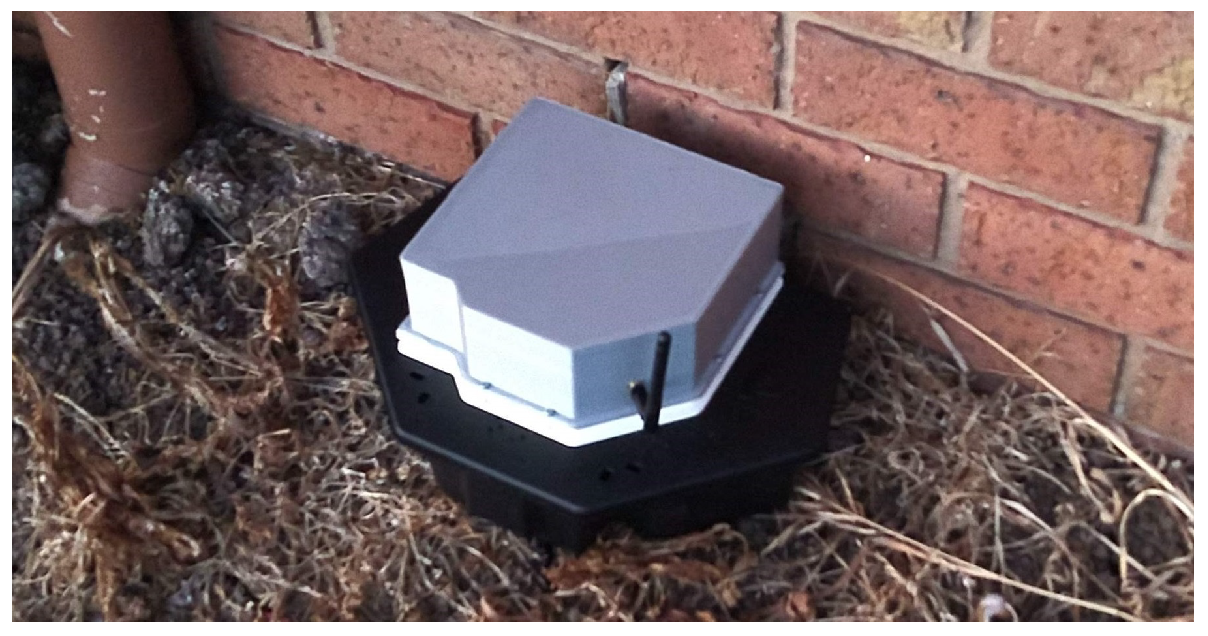
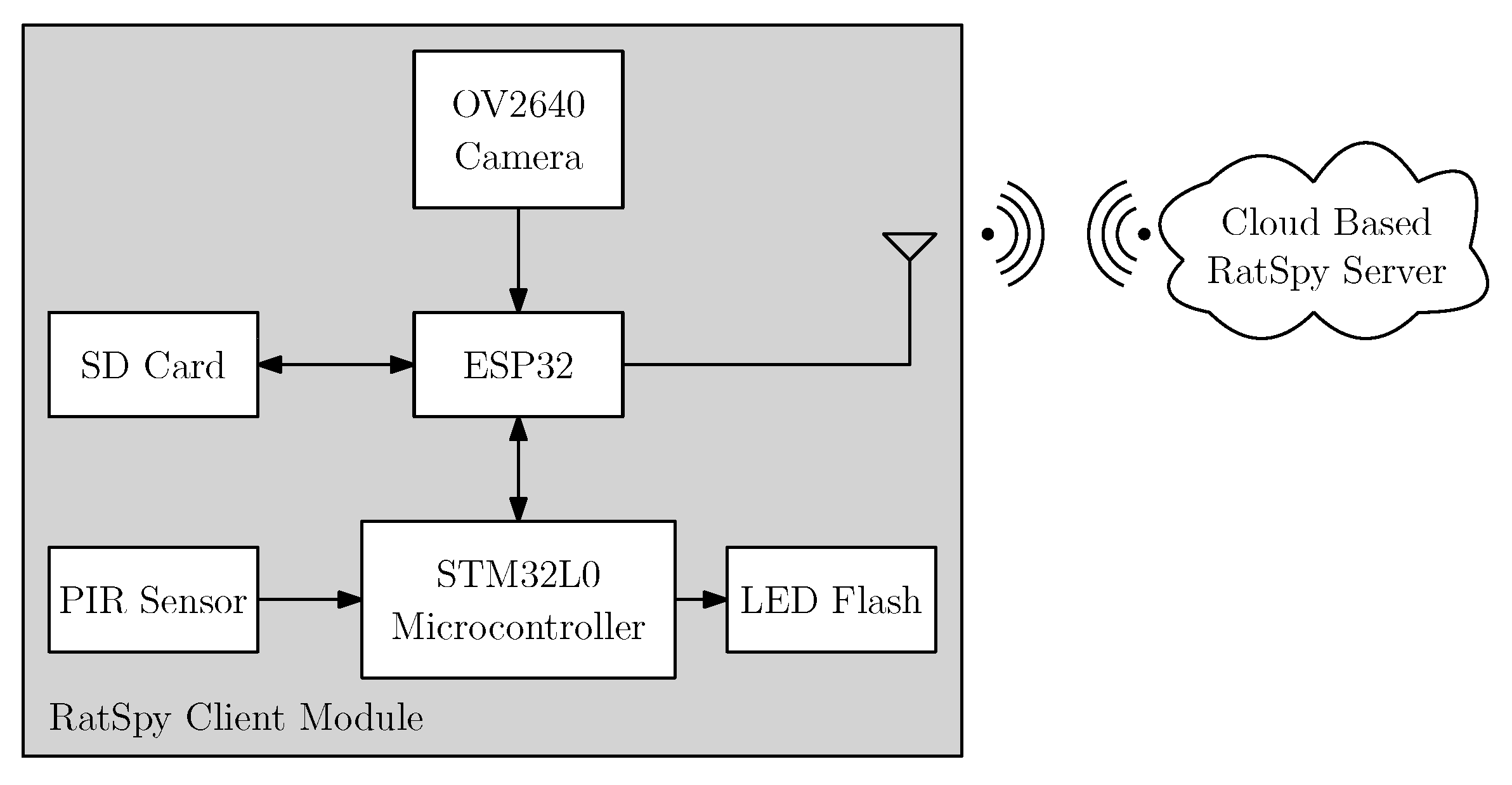
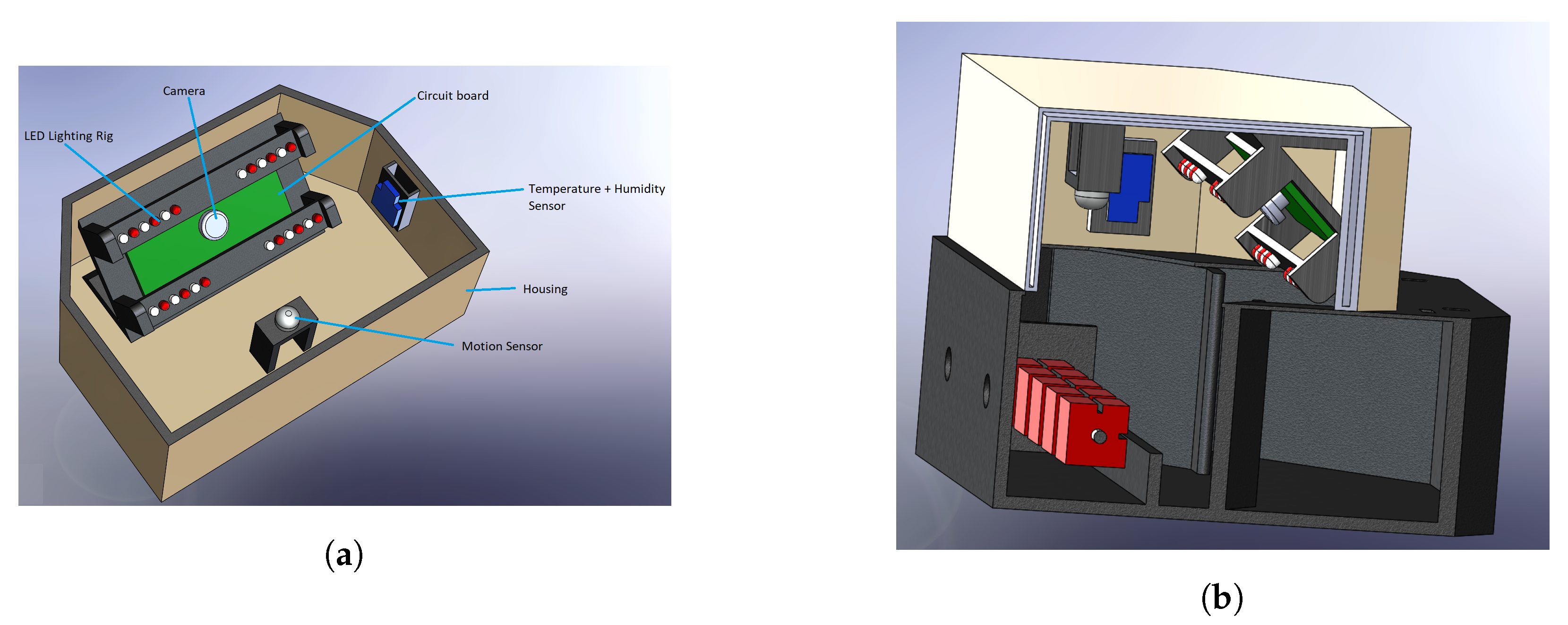

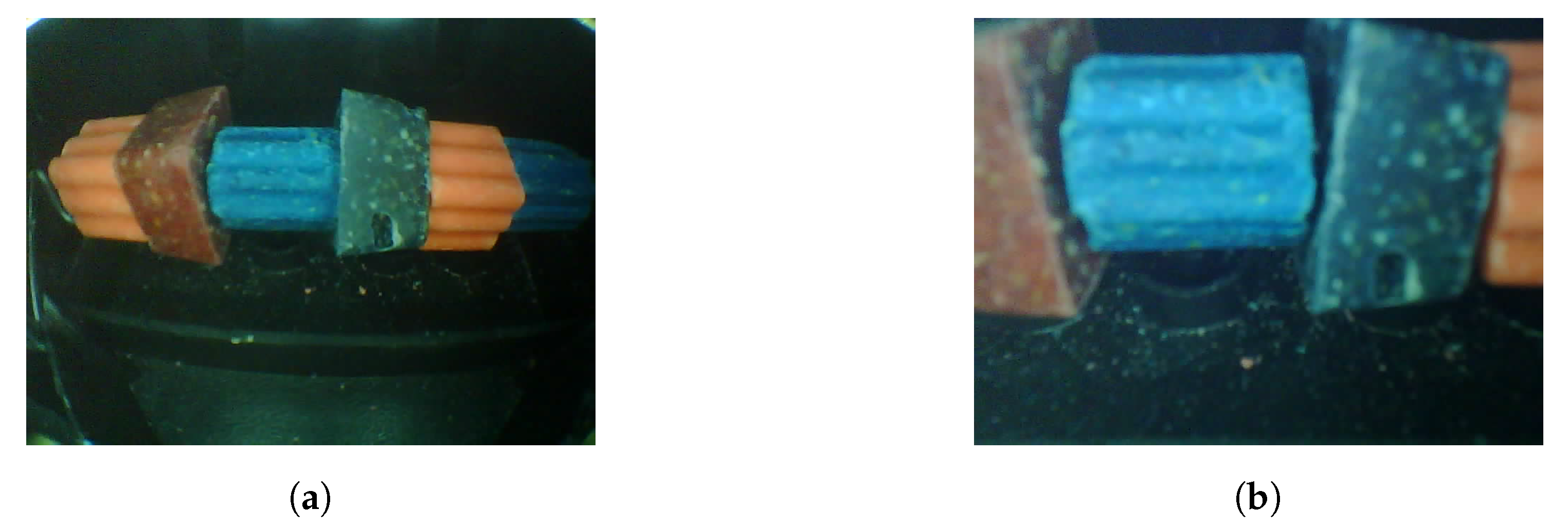
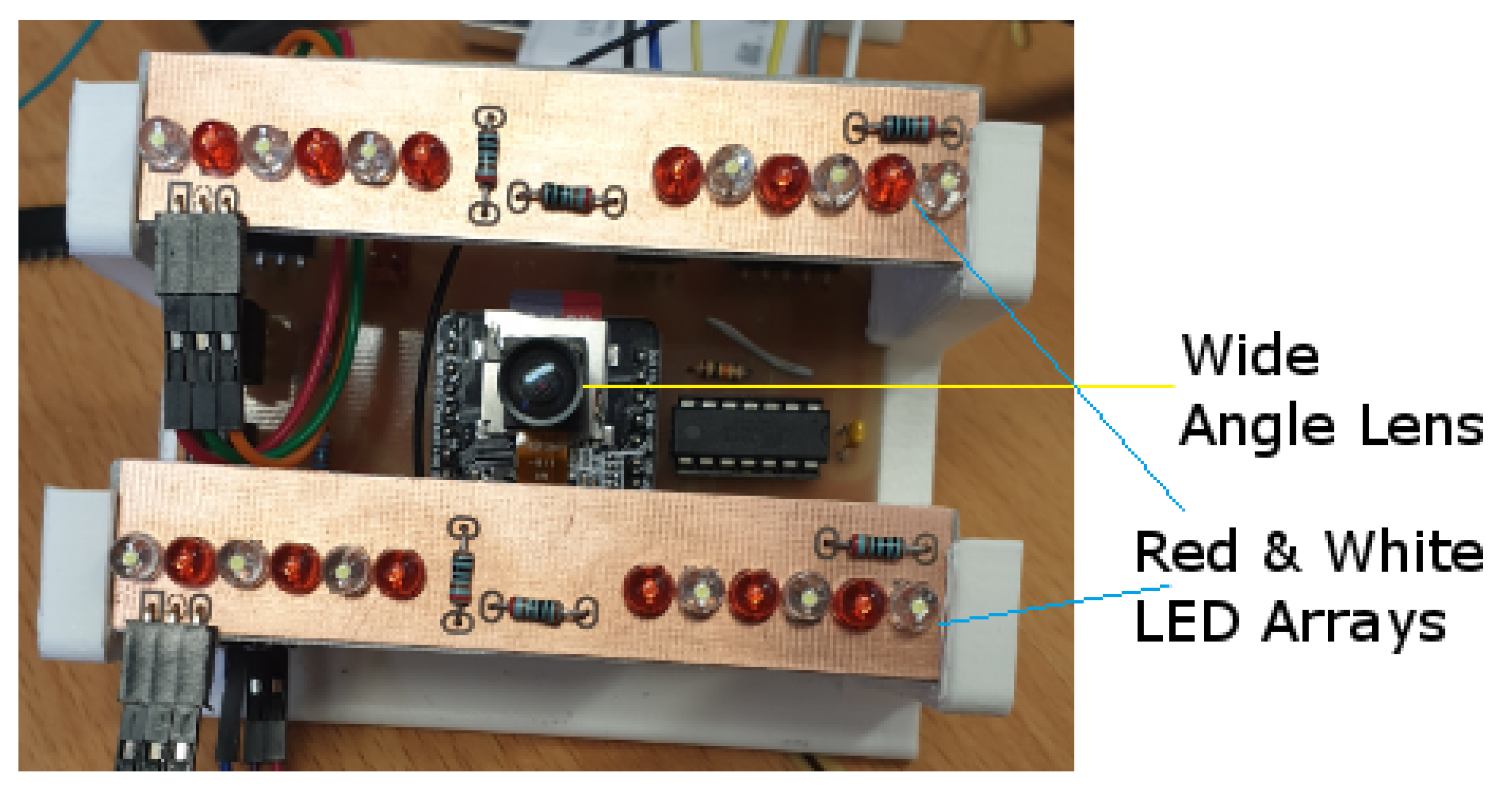
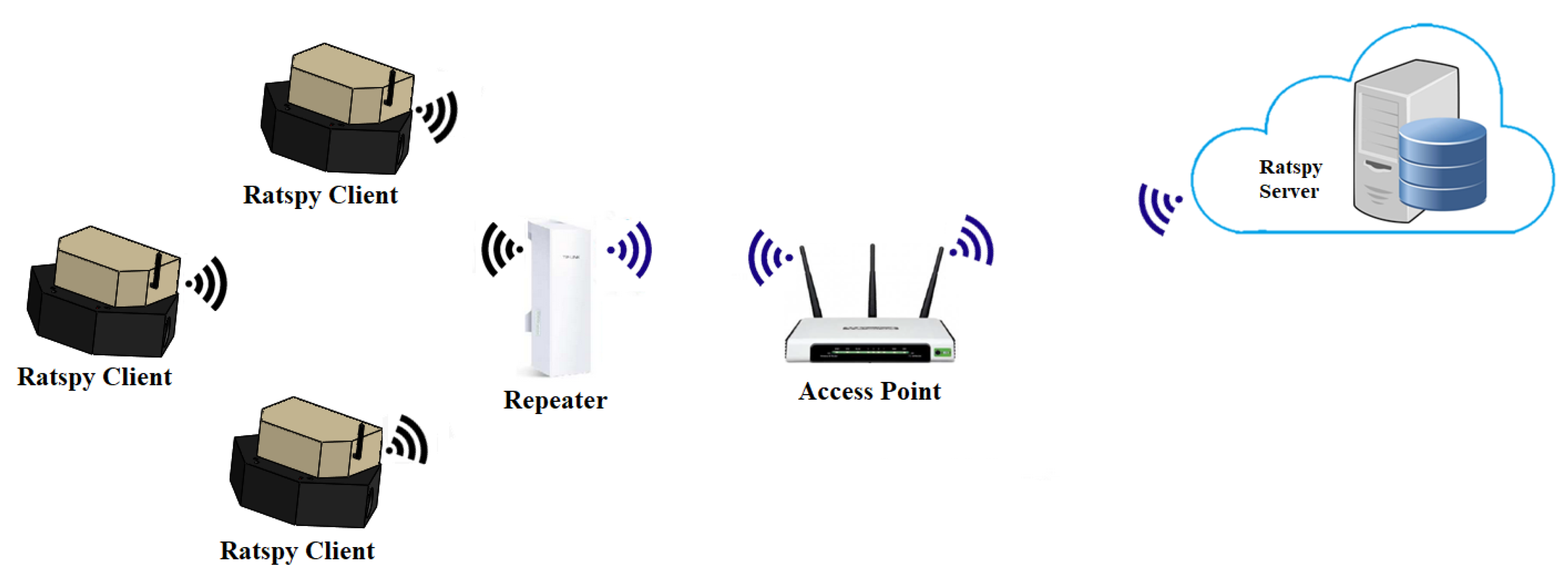


| Characteristic | Sub-Characteristic | Requirements |
|---|---|---|
| Functional Suitability | Functional Completeness | Upload image for analysis of bait type, bait level, and intruder occurrences. Upload temperature, humidity, and battery level data |
| Functional Correctness | Bait level estimate within 15%. Temperature accurate to ±2 °C and humidity to 5% | |
| Functional Appropriateness | Integration with existing bait station hardware | |
| Performance Efficiency | Time-behaviour | Bait images captured once per day. Intruder images captured each time PIR sensor is triggered |
| Resource Utilization | Inexpensive system which reduces labour costs involved with manual bait station inspections | |
| Capacity | Can operate for up to 6 months from AA batteries | |
| Compatibility | Co-existence | System can be used with traditional bait stations |
| Interoperability | Connects to any WiFi network (WPA security). Bait stations act as clients to a cloud based server. | |
| Usability | Appropriateness recognisability | Users see images of bait station intruders as well as bait levels |
| Learnability | Simple to set up on site and register device on website | |
| Operability | User friendly website which displays on mobile and PC | |
| Accessibility | Service panel for battery replacement and maintenance | |
| Reliability | Fault Tolerance | Data sent over WiFi is logged onto SD card for redundancy |
| Recoverability | Manual reset button. Low battery warning sent to website. Critical data stored on SD card. Self-reset on battery replacement | |
| Security | Non-Repudiation | Images from bait station are time and date stamped. Software tokens give each registered bait station a unique identifier |
| Maintainability | Reusability | New devices can be registered on website for monitoring |
| Testability | Bait estimate confirmed against visual inspection. Intruder verified by uploaded images | |
| Portability | Installability | WiFi initialization and token registration using data stored on SD card |
| Replaceability | Add-on device can be field swapped |
| Characteristic | Sub-Characteristic | Requirements |
|---|---|---|
| Effectiveness | Up to date data logged to cloud for bait type, bait estimate, intruders, temperature, humidity and battery level | |
| Efficiency | Labour cost related to bait station monitoring minimized | |
| Satisfaction | Usefulness | Improves pest management approach with near real-time data. Facilitates remote monitoring of widespread bait stations |
| Trust | Visual inspection of uploaded images validates bait level estimates | |
| Freedom from Risk | Economic Risk mitigation | Low cost per unit for system set-up and maintenance |
| Health and Safety Risk Mitigation | Used as an add-on to traditional lockable bait stations | |
| Environmental Risk Mitigation | Visual inspection of images showing intruders can be used as an early indicator of non-target species consuming the bait | |
| Context Coverage | Context Completeness | Preliminary field testing |
| Flexibility | Can be modified for remote monitoring of other pest traps |
| Sensing Device | Sensed Parameter | Accuracy | Current Consumed |
|---|---|---|---|
| DHT11 | Temperature + Humidity | ±2 °C and ±5% respectively | 2.5 mA |
| HC-SR501 PIR | Motion | - | 450 μA (sleep), 8.9 mA (active) |
| 100 K Voltage Divider | Battery Voltage | ±1% | 15 μA at 3 V |
| OV2640 2MP camera | Visual (Image) | - | 40 mA (active) |
| Technology | Traditional Baiting | Trigger Report | Trail Camera | Displacement Sensor | Vision Bait Estimation |
| Examples | Standard Practice [14] | SMARTeye, Pestconnect [17] | ScoutGuard [34] | RatTrace [23] | RatSpy |
| Bait Level | No—manual check | Inferred from number of intruders | No | Yes—Limited | Yes—automatic |
| Bait Condition | No—manual check | No—manual check | No—NA | No—manual check | Yes—manual from photo |
| Visit Notification | No | Yes | Yes | Yes | Yes |
| Visitor Identification | No—scat identification | No | Yes | No | Yes—manual from photo |
| Remote Connectivity | No | SIM | None or SIM | WiFi or LoRA | WiFi |
| Data Latency | 2 week checking | <10 s | Manual or <10 s | <10 s | <10 |
| Additional Unit Cost (USD) | Base | $50–$80 | $50–$300 | $20 | $25 |
| Cause | Occurences |
|---|---|
| Rodent | 15 |
| Lizard | 4 |
| Spider | 91 |
| Unknown | 55 |
| Mode | Average Current | Time Fraction |
|---|---|---|
| Sleeping | 600 μA | 99.984% |
| Image Capture | 150 mA | 0.004% (4 s per day) |
| Communication | 200 mA | 0.012% (10 s per day) |
| Average Current: | 630 μA | |
© 2020 by the authors. Licensee MDPI, Basel, Switzerland. This article is an open access article distributed under the terms and conditions of the Creative Commons Attribution (CC BY) license (http://creativecommons.org/licenses/by/4.0/).
Share and Cite
Ross, R.; Parsons, L.; Thai, B.S.; Hall, R.; Kaushik, M. An IoT Smart Rodent Bait Station System Utilizing Computer Vision. Sensors 2020, 20, 4670. https://doi.org/10.3390/s20174670
Ross R, Parsons L, Thai BS, Hall R, Kaushik M. An IoT Smart Rodent Bait Station System Utilizing Computer Vision. Sensors. 2020; 20(17):4670. https://doi.org/10.3390/s20174670
Chicago/Turabian StyleRoss, Robert, Lyle Parsons, Ba Son Thai, Richard Hall, and Meha Kaushik. 2020. "An IoT Smart Rodent Bait Station System Utilizing Computer Vision" Sensors 20, no. 17: 4670. https://doi.org/10.3390/s20174670
APA StyleRoss, R., Parsons, L., Thai, B. S., Hall, R., & Kaushik, M. (2020). An IoT Smart Rodent Bait Station System Utilizing Computer Vision. Sensors, 20(17), 4670. https://doi.org/10.3390/s20174670






